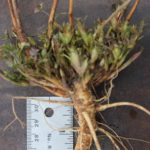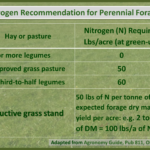Conditions: Moderate temperatures at the end of winter, combined with limited precipitation minimized spring water runoff and soil erosion. Soil is drying slowly, allowing for only limited field activity to date.
Alfalfa: Winter survival generally looks excellent. Alfalfa has 1 to 2 inches of new growth at this point and is showing no sign of heaving damage. Tap roots just below the crowns, Figure 1, are generally firm and show no sign of winter frost injury. Fall harvested fields are showing minimal growth to date. Forage inventories are good, which will provide opportunities to rotate some of the weaker forage stands, most likely to corn, if the season is early enough.
Figure 1. Alfalfa crown with firm tap root
Grass Forages: Need to apply nitrogen as soon as ground is dry enough to support equipment. See Figure 2 for rates.
Figure 2. Nitrogen Recommendation for Perennial Forages
Winter Wheat: Winter survival is very good on well drained soils. Plants are greening up. Very little nitrogen has been applied to date. A limited amount of red clover has been broadcasted. With adequate moisture, red clover can be successfully seeded into winter wheat until early May. Note: Growers should be aware that Agricorp/Crop Insurance has coverage for establishment protection of red clover, see New Forage Seeding Plan.
Spring Cereals: Over the last month, demand for spring wheat seed picked-up, but seed supply is very tight to non-existent. Grain market opportunities for mixed spring cereals (mixtures of barley, oats and/or wheat) are very limited and as such, growers should secure an outlet/market for their crop before seeding mix cereals.
Corn: Still a few 2014 corn fields to harvest, mostly in the upper Ottawa Valley. Grain corn bushel weight only improved slightly over the winter, while moisture has dropped to 13 – 15%. Old crop standability is hybrid and location specific. With a significant amount of corn still in storage, growers are encouraged to monitor bins for grain moisture/quality. Planting intentions point to a slight acreage increase over last year. Fertilizer supplies are adequate.
Soybeans: The slight shift downward in soybean planting intentions is in part due to the need for crop rotation following heavy white mould pressure in 2014. IP Soybean growers should check with their buyers to see which pesticides are permitted under their contract.
Weed Resistance: Acreage infested with common ragweed, pigweed species, lamb’s quarters and eastern black nightshade resistant to Group 2 herbicides (eg. Pursuit, Classic, Pinnacle, FirstRate, etc.) continues to increase. For the first time, glyphosate resistant Canada fleabane has been confirmed at 3 locations in eastern Ontario.
Figure 3. Canada fleabane rosettes
Crop Insurance/Agricorp Update: Rain gauge options for the Forage Rainfall program have been expended. Up to three rainfall stations can be chosen instead of only one. More information at: http://bit.ly/1O0cHGq
Source Water Protection:
What: Training session for drinking water protection
Who: Custom applicators in the Raisin and South Nation Region
Why: To inform you of new regulations that applies to your work
Where: South Nation Conservation Office, 38 Victoria Street, Finch ON
When: Wednesday, April 22, 2015 from 9:00 a.m. – 12:00 p.m.
To R.S.V.P. Please Contact Alison McDonald: 1-613-984-2948 x311 or amcdonald@nation.on.ca
Next meeting:
7:30 am, April 28th, Country Kitchen Restaurant, Highway 31, Winchester, ON.
Important Date:
July 21 – Eastern Ontario Crop Diagnostic Day, Winchester Research Farm.


